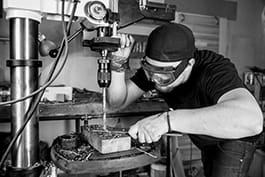Profession boring machine operator

Boring machine operators operate machinery and equipment at mining and drilling sites, e.g. for construction, exploration, extraction and research.
Boring machine operator Jobs: Open positions
Find the job of your dreams on Talent.com, one of the largest job sites worldwide.
Job postings: talent.comPersonality Type
Tasks boring machine operator
- Move drilling equipment to the right location, e.g. by driving or controlling its load and upload.
- Set up drilling and hoisting machinery, e.g. by connecting drill pipe sections, etc.
- Connect power cables or hoses for water and air supply.
- Operate the drilling machinery, e.g. by regulating pressure of tools, controlling the speed of rotary tables and air flow, etc.
- Operate slush pumps in order to ensure circulation and consistency of drilling fluid or mud in well.
- Correct problems in drilled holes caused by mechanical breakdowns or by harmful natural conditions.
- Locate and recover lost or broken bits, casings, drill pipes, etc. from wells using special tools.
- Maintain records, e.g. of footage drilled, materials and tools used, etc.
- Report information about the drilling process to the supervisor.
- Supervise and train crew.
Related professions oil, gas
- Boat or derrick operator
- First line supervisor oil or gas workers
- Gas compressor or gas pumping station operator
- Mains pipes layer-jointer
- Oil or gas geologist
- Oil or gas well driller
- Oiler, greaser
- Operator service unit oil or gas well
- Petroleum chemist
- Petroleum or natural gas refining plant operator
- Pipe fitter
- Pipeline worker
- Roustabout oil or gas
- Well digger
- Well driller (not in gas and oil)
- Well service unit operator (not in gas and oil)
- Well sinker
Knowledge
- Quality standards
The national and international requirements, specifications and guidelines to ensure that products, services and processes are of good quality and fit for purpose.
- Types of boring heads
Qualities and applications of various types of boring heads, such as rough boring heads, fine boring heads and others.
- Types of drill bits
Qualities and applications of various types of drill bits, such as core drill bits, spotting drill bits, countersink drill bits and others.
- Types of metal
Qualities, specifications, applications and reactions to different fabricating processes of various types of metal, such as steel, aluminium, brass, copper and others.
Skills
- Dispose of cutting waste material
Dispose of possibly hazardous waste material created in the cutting process, such as swarf, scrap and slugs, sort according to regulations, and clean up workplace.
- Perform test run
Perform tests putting a system, machine, tool or other equipment through a series of actions under actual operating conditions in order to assess its reliability and suitability to realise its tasks, and adjust settings accordingly.
- Monitor automated machines
Continuously check up on the automated machine's set-up and execution or make regular control rounds. If necessary, record and interpret data on the operating conditions of installations and equipment in order to identify abnormalities.
- Ensure equipment availability
Ensure that the necessary equipment is provided, ready and available for use before start of procedures.
- Troubleshoot
Identify operating problems, decide what to do about it and report accordingly.
- Tend boring machine
Tend a boring machine, monitor and operate it, according to regulations.
- Supply machine
Ensure the machine is fed the necessary and adequate materials and control the placement or automatic feed and retrieval of work pieces in the machines or machine tools on the production line.
- Supply machine with appropriate tools
Supply the machine with the necessary tools and items for a particular production purpose.
- Remove processed workpiece
Remove individual workpieces after processing, from the manufacturing machine or the machine tool. In case of a conveyor belt this involves quick, continuous movement.
- Remove inadequate workpieces
Evaluate which deficient processed workpieces do not meet the set-up standard and should be removed and sort the waste according to regulations.
- Set up the controller of a machine
Set up and give commands to a machine by dispatching the appropriate data and input into the (computer) controller corresponding with the desired processed product.
- Operate precision measuring equipment
Measure the size of a processed part when checking and marking it to check if it is up to standard by use of two and three dimensional precision measuring equipment such as a caliper, a micrometer, and a measuring gauge.
Optional knowledge and skills
cutting technologies types of metal manufacturing processes manufacturing of light metal packaging manufacturing of cutlery inspect quality of products manufacturing of metal containers record production data for quality control perform machine maintenance manufacturing of steel drums and similar containers manufacturing of steam generators mechanics provide advice to technicians manufacturing of heating equipment manufacturing of doors from metal non-ferrous metal processing operate scrap vibratory feeder manufacturing of small metal parts perform product testing mark processed workpiece ferrous metal processing keep records of work progress manufacturing of metal structures manufacturing of weapons and ammunition manufacturing of door furniture from metal apply cross-reference tools for product identification manufacturing of metal household articles manufacturing of tools consult technical resources manufacturing of metal assembly products monitor conveyor belt monitor stock levelSource: Sisyphus ODB